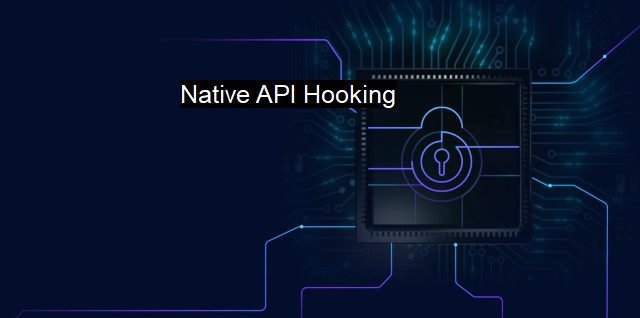What is Native API Hooking?
Exploring Native API Hooking: An Innovative Cybersecurity Technique for Evasion from Antivirus Detection
Native API hooking is a pro-active cybersecurity technique that essentially involves intercepting and altering the behavior of system-level API calls. This technique is often used in antivirus systems, intrusion detection systems, system monitoring tools, and many other software types to get underneath application layers and tangibly affect the system-level operations.Definitions aside, a more in-depth understanding of Native API hooking involves unpacking it piece by piece. APIs or Application Programming Interfaces are essentially code libraries provided by operating systems that grant applications access to system resources and functionalities. Every time an application is run, several underlying API calls are made to the operating system. These APIs form the basic communication channel between the software and the hardware components of a computer system.
API hooking specifically refers to intercepting these API function calls and extending, altering, or redirecting their functionality. This technique involves redirecting an original API function call to a third-party function, which is additional to the software. The third-party function can perform a variety of actions, it can entirely replace the original function behavior, be an additive to it or, some cases, even block it completely.
Within the sphere of cybersecurity, Native API hooking is used broadly and forms the crux of many popular antivirus software. By examining API calls, antivirus software can mitigate attacks that exploit applications at the system level. API hooking allows the detection software to intercept suspicious calls, evaluate their validity and credibility, and block them if deemed harmful. By actively manipulating the API calls, the antivirus can substantially disrupt an attacker's actions and limit the reach of their malicious code.
API hooking is not just bounded by intercepting malicious actions. Many software debugging tools use it for altering specific bug behavior in order to understand, monitor, and ultimately fix problematic scenarios. It can also be extensively used for code profiling and analyzing performance issues in a system.
It is important to understand that Native API hooking, while a potent tool, isn't without its challenges and drawbacks. As powerful as this tool is in the hands of cybersecurity professionals, it can create a field day for malevolent hackers when used maliciously. An attacker may use Native API hooking to infiltrate systems, alter normal API behaviors, install rootkits, or create backdoors to gain unauthorized access and exploit system vulnerabilities.
Another challenge lies in the inherent complexity and sophistication of API hooking as a technique, making it hard to comprehensively verify and certify security measures in an enriched API hooking environment. When the security software manipulates API behavior, debugging and tracing software errors can become incredibly challenging.
Using Native API hooking can trigger false positives or false negatives because the process's unpredictable nature can interfere with seemingly innocent or routine APIs. This can often be frustrating and can potentially compromise the effectiveness of the protective software, while requiring substantial computing resources, thus affecting overall system performance.
Native API hooking is an invaluable cybersecurity asset but must be used carefully and with consideration to its associated vulnerabilities. By realistically navigating its challenges, using mitigative security measures, and maintaining thorough scrutiny of the hooking process, Native API hooking can perform feasibly for improving systematic security as well as optimizing system output. Understanding this method, its potential benefits, and inherent struggles, is essential for any cybersecurity professional, as it remains a prominent tool within the defensive aids against the modern era's software breaches.

Native API Hooking FAQs
What is native API hooking?
Native API hooking is a technique used in cybersecurity to intercept and modify the behavior of an application by modifying the API calls it makes to the operating system. It is commonly used in antivirus software to intercept system calls made by malware and prevent it from executing.How does native API hooking work?
Native API hooking works by intercepting the system calls made by an application and redirecting them to a custom code that can modify the parameters or behavior of the call. This can be done by injecting a DLL into the application process, which contains the hook code.What are the benefits of native API hooking?
The benefits of native API hooking include the ability to intercept and modify system calls made by malicious software, the ability to monitor and control the behavior of applications, and the ability to add additional security features to an application.What are the risks of using native API hooking?
The risks of using native API hooking include the potential for system instability or crashes if the hook code is not correctly written or if it interferes with other system processes. Additionally, it can be difficult to ensure compatibility with all versions of the operating system and all applications, which can lead to unpredictable behavior. Finally, there is the risk that the hook code itself could be targeted by attackers, potentially allowing them to bypass security measures.| | A | | | B | | | C | | | D | | | E | | | F | | | G | | | H | | | I | | | J | | | K | | | L | | | M | |
| | N | | | O | | | P | | | Q | | | R | | | S | | | T | | | U | | | V | | | W | | | X | | | Y | | | Z | |
| | 1 | | | 2 | | | 3 | | | 4 | | | 7 | | | 8 | | |||||||